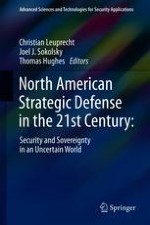The protection of the homeland is the top priority for U.S. national security strategy. Strategic defense, however, has been an overlooked dimension in the vast literature on the U.S. strategic posture, with even less attention given to the necessity and dynamics of security collaboration within North America. Drawing on the expertise of scholars from the U.S., Canada and Mexico, the book offers a wide range of perspectives on recent trends in, and future prospects for, the military and political evolution of North American strategic defense.
North American strategic defense is a topic too often taken for granted: as this excellent book shows, that is a mistake. In the 21st century, perhaps even more than the 20th, it will be an issue of cardinal importance to both the United States and Canada.
Eliot A. Cohen
Robert E. Osgood Professor of Strategic Studies, Johns Hopkins School of Advanced International Studies
NORAD’s binational command is unique, and this timely and ambitious book examines its continued relevance to North American defense against a host of new global threats. It broadens the focus of what we mean by North American defense, contemplates how we might include Mexico in various regional security arrangements, and considers the dynamics of expanded North American interdependence in the Trump era.
Laura Dawson
Director of the Canada Institute, Woodrow Wilson International Center for Scholars
North American Strategic Defense in the 21st Century is an important book. This edited volume brings together a galaxy of stars, both rising and established, with outstanding credentials regarding NORAD and associated matter in the study of security. This original and well-written volume is the first of its kind since the Cold War – long overdue and impressive in contents. The chapters cover both panoramic issues and more specific matters, and the collection is essential reading for academics, policy-makers and the general public.
Patrick James
Dornsife Dean’s Professor, School of International Relations, University of Southern California
